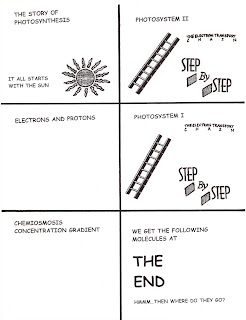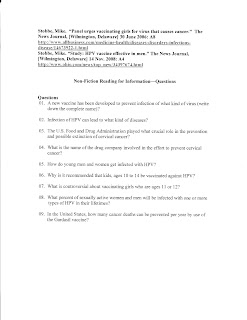For about six years, I have been teaching some lessons about cancer that are culminating lessons for a unit of study on genetics. Here are some teaching resources that I use:
I show students videos from an NIH CDROM and use the Understanding Cancer student worksheets from the following resource materials that can be ordered from NIH.
Cell Biology and Cancer
http://science.education.nih.gov/supplements/nih1/cancer/default.htm
Students are assigned nonfiction reading and answer questions that are designed so that students are reading for information. The first article is:
Henrietta's Dance by Rebecca Skloot
http://www.jhu.edu/jhumag/0400web/01.html
Henrietta’s Dance – Reading Questions
A printable copy of the Questions can be found by clicking on this link:
https://drive.google.com/file/d/1xQzdrrrycG6ZQ6aaLlJx-_SaJM6sIcZW/view?usp=sharing
Name __________________________
01. What was the symptom that caused Henrietta to go to the doctor?
02. When the doctors examined Henrietta, what did they find?
03. What disease did Henrietta have?
04. What does the term “malignant” mean?
05. What did the doctors use as an attempt to cure Henrietta’s disease?
06. What were Margaret and George Gey looking for, and what did they do with them?
07. What was remarkable about HeLa cells?
08. What was the mystery about the polio virus that had to be solved, before a vaccine
could be developed?
09. What were at least 3 uses that researchers had for the HeLa cells?
10. How did the doctors talk David Lacks into allowing them to take cell samples from
Henrietta?
11. How did the Lacks family find out about the HeLa cells, 24 years later?
12. What had happened with the HeLa cells that made the Johns Hopkins researchers
want to take blood and tissue samples from the Lacks family?
13. What information did the researchers want to get from the blood and tissue samples?
14. How quickly did the HeLa cells reproduce a generation?
15. What are two of the ethical questions that the Lacks case brings up?
16. What are some of the changes in scientific research that have been made, since the
doctors took the cells from Henrietta?
17. What was one of the main reasons that this article was written?
18. How does the Lacks family feel about what happened with Henrietta’s cells?
Reading Questions were written by teacher, LaRaine Beckhorn
If you would like to print out a copy of the reading questions, you can use this link:
https://drive.google.com/file/d/1xQzdrrrycG6ZQ6aaLlJx-_SaJM6sIcZW/view?usp=sharing
If time is short, here is a shorter version of the questions:
https://drive.google.com/file/d/1RPQDHkSnTbQI6c8JJu6Y8JNrrLaFVTDK/view?usp=sharing
After students read about the history of Henrietta Lacks and HeLa cells, they read a second article, which is informative about cervical cancer, the human papilloma virus, and the use of vaccines to cure cancer.
Sticking It to Cancer - Nonfiction Reading
The
Sticking It to Cancer article, as a PDF, can be found
here:
https://drive.google.com/drive/folders/0BzkmlZHn4HtJNnBNUkhVZVg2WHc The reference for the article is: Fischman, Josh. April 2006. U.S. News & World Report, 04/03/2006, Vol. 140, Issue 12, p. 56
Sticking It to Cancer
Non-Fiction Reading for Information—Questions
A printable copy of the questions can be found by clicking this link:
https://drive.google.com/file/d/1hsq2qLG4wJ31aUk2TPzsaQ7MtTrUmO69/view?usp=sharing
1. Do not write on this question sheet.
2. Answer the questions on loose leaf paper.
3. For each question, write down the first four letters of the paragraph(s) where you
found the answer(s).
4. Write in complete sentences and hand in.
Introductory Information:
At the top of your paper write your name, the date, and the period.
Find and write down the name of the magazine, where the article was published.
Find and write down the date that the article was published.
Questions
1. A new vaccine has been developed to prevent infection of what kind of virus (write
down the complete name)?
2. Infection of HPV can lead to what kind of diseases?
3. The U.S. Food and Drug Administration will play what crucial role in the prevention
and possible extinction of cervical cancer?
4. What are the names of the drug companies involved in the effort to prevent cervical
cancer and what roles are the drug companies playing in cancer prevention?
5. Name two cancers, in addition to cervical cancer, that might be prevented by
vaccination.
6. What has DNA analysis revealed about the link between HPV and cervical cancer?
7. How do young men and women get infected with HPV?
8. After the initial infection, how long does it take for cancer to develop?
9. Describe another technique that also involves the immune system in fighting cancer?
10. How does the Merck Guardasil vaccine trigger the immune system to make
antibodies against HPV?
11. How does the Provenge vaccine work against prostate cancer?
12. Why is it recommended that kids, ages 10 to 14 be vaccinated against HPV?
13. What is controversial about vaccinating girls who are ages 11 or 12?
14. Why is it going to be important for women to continue to have regular Pap smears?
(Pap is an abbreviation for Papanicolaou, and is an invention of Dr. Georgios
Papanikolaou (1883-1962), a Greek who later immigrated to the United States; the
father of cytopathology. Cells are scraped from the cervix and examined for
abnormal cell division.)
15. How does the Panvac VF vaccine work to destroy Pancreatic cancer cells?
16. Describe the experimental treatment for melanoma and how it works.
Reading Questions written by teacher, Christine M. Anderson, 3/31/2006, for Middletown High School.
I also came up with a shortened version of these reading questions that match up to some news articles because there were times I needed to be flexible with the time that I was spending on the lessons and also some students needed some shorter articles that were easier to read.
https://drive.google.com/open?id=1Q32JLQXxW9cyLtNon1IqbbYawC6a4NX-
Also, I just finished reading a book,
The Immortal Life of Henrietta Lacks
, by Rebecca Skloot, which would be of interest to students and teachers. Her web site also has links to some videos, including a video of dividing HeLa cells.
http://rebeccaskloot.com/
Update: Here is a link to an interview with Rebecca Skloot about her book that was aired on Book TV on 3/19/2010:
http://www.c-spanvideo.org/program/292685-7
Random House has also made available discussion, reading, and study guides to go with the book, which are available for download at the bottom half of this link:
https://penguinrandomhousesecondaryeducation.com/book/?isbn=9781400052189
Update 08/31/2018. The September 18 issue of
The Science Teacher, NSTA magazine, Volume 86, Number 2, p. 15 has a description of
Teaching Resources on Henrietta Lacks that are based on the book written by Rebecca Skloot, They were compiled by Ohio biologist/educator Christopher Monsour. Here is a link to the resources:
http://goo.gl/xd3Rg9 or
https://drive.google.com/drive/folders/0ByYJKAo4du5LNWMtUGdxN1dCWVk
Update: Oprah Winfrey has announced that she is making a film about Henrietta Lacks!
http://www.huffingtonpost.com/entry/hbos-the-immortal-life-of-henrietta-lacks-gets-release-date_us_58a35e8be4b0ab2d2b19b5b2
The HBO presentation of “The Immortal Life of Henrietta Lacks,” based on the book by Rebecca Skloot, is slated to debut Saturday, April 22, at 8 p.m. EST.
I have just watched the HBO presentation "The Immortal Life of Henrietta Lacks," starring Oprah Winfrey. The video may be interesting to those who wish to view a drama about Henrietta Lacks, but the film is not a suitable one for use in the classroom. This is rather disappointing because I was hoping to be able to have an up-to-date, documentary film that could supplement lessons on cancer. The film focuses on the Lacks family and has some mature themes dealing with mental illness, inappropriate language for middle and high school, child abuse and a rape scene. African American studies courses in college could use this video as a supplement. The film is also lengthy and for students, the dialogue might not hold their interest. There is a family featurette at the end of the video. It has some information, but I cannot recommend it as a classroom resource. Mrs. A. 01/13/2018.
I have found some video resources that may be useful. The first four are about the immortal cells of Henrietta Lacks:
The following lesson was used as an assessment/summarizing activity for students, so that they could demonstrate what they had learned about cancer.
Use of Graphic Organizer Introduces Students to New Information in the Subject Area
Purpose Students will practice self-regulated learning by producing a tri-fold brochure that assists them in organizing new information that has been presented. This brochure will be a brochure that can inform and teach others about cancer.
Goals 1. By the end of the lesson, students will be able to find facts and organize reading material.
2. Students will demonstrate the skill of “reading for understanding and organizing information.”
Activity Pass out a sheet of plain, unlined paper (to be used for the brochure) to each student. Instruct and demonstrate to students how to fold the paper into three sections. Indicate where to put the information in the brochure: Front cover to be labeled Understanding Cancer. Inside front cover to be labeled What is Cancer?, in the middle section label should read, Causes of Cancer, inside right, Types of Cancer, and the remaining section, Treatments for Cancer. The back can be used for additional notes. Students can use the information in their binders, as well as the two reading packets:
Henrietta’s Dance, and
Sticking It to Cancer. Written information, such as facts and vocabulary should be written under each label in the brochure. There should be at least 10 facts for each section. Have the students write down the facts first and then, they may illustrate their brochure with available materials.
Materials Plain unlined paper
Colored pencils, pens.
Grouping Assignment choice: Assigned by teacher – groups of four
Brochure: individual
Discussion: whole class guided by instructor as coach; students may talk quietly while working, but must stick to the topic of their work and not distract others. Monitor their progress.
Reflection: individual
Learning Dependent: structure assignment
Styles Collaborative: students may talk quietly to each other
Independent: activity can be completed on own
Concrete Experience: activity is hands-on and real-life
Reflective Observation: completing tasks give sense of accomplishment
Abstract Conceptualization: activity demonstrates many new possibilities for learning
Active Experimentation: student explore how to efficiently accomplish tasks
Steps Pre-teach activity
Follow-up so that students complete activity
Follow-up Activity prepares students for organizing and learning new information
Evaluation Brochure will be used for study.
Textbook
Internet Site
____________________________________________________________________________________________
Lesson plan prepared by Christine M. Anderson for Business Ed., Stanton Middle School 11/14/99 and revised for Coordinated Science II, Middletown High School, 11/13/05 and 12/14/09. To print out the original lesson plan, you can click on this link:
https://drive.google.com/file/d/1A_zXGrTWh0TlF3CFxtsP1RWM_vh3vzWi/view?usp=sharing
Update May 8, 2018:
National Portrait Gallery Presents a Portrait of Henrietta Lacks, a Co-Acquisition with the National Museum of African American History and Culture
https://nmaahc.si.edu/about/news/national-portrait-gallery-presents-portrait-henrietta-lacks-co-acquisition-national
Here is a very interesting article about a transmissible cancer in Tasmanian devils:
Nervous culprit found. ScienceDaily. Retrieved July 5, 2010, from
http://www.sciencedaily.com/releases/2009/12/091231164736.htm
and here is a video clip:
http://www.youtube.com/watch?v=j3jy3mzrEe4&ytsession=ZrZfx597QcNM1SxEkTfjnjeTTTHrxZz4OphEnXrod7macd0qjm05Xib4jl7b_lbf2GD2PKuTaRfrEwSpqaxJJcPfvx_BCZKv_F9BERRVRxo2gURT9pdHCaG0K1k9REg46ZZnsPe0TE0n3Gb2WqTIejW0j6YbYn2j7j6mmPR4Oo_eBDRyBt_SWJi6Cz-sC1Vz_sQL65libG713JTsnwoTXWBVJ5unWPvAuWyuV97J7-34ZTyjk2GAim2PozIkBoVl_JOyjIBvquK9Ie54uVPONnJCwZG139yxRKkstOnxXPu_-5NlwSfvLKQvi9SvmyPK
If you are teaching about cancer and would like to use a case study about Cancer and Tasmanian Devils, there is a case study at this link:
http://sciencecases.lib.buffalo.edu/cs/collection/detail.asp?case_id=588&id=588
If you find a link on my blog that is not working, please let me know by leaving a comment. I would like to keep the resources on my blog up-to-date, correct, and relevant.






















